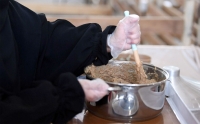
Hanaini is a traditional dish in the Kingdom of Saudi Arabia , particularly popular among the people of Qassim Province in the central north of Saudi Arabia. It is commonly prepared during the winter season, as it contains a high amount of calories, providing the body with energy and warmth. Preparation method of Hanaini Hanaini is made from Al-bur (whole wheat grains), known as ' Al-Laqeemi, ' 'Al-Jareeba,' ' Al-Umaydiya, ' ' Al-Halba, ' and ' Al-Ma...

The International Tea Colors Exhibition is the first exhibition specializing in tea and its related products, including baked goods, nuts, etc. It was held in Riyadh City , the capital of the Kingdom of Saudi Arabia , in 2023, with the participation of several local and international brands specializing in tea, alongside experts and professionals in the field. The exhibition brought together producers, consumers, suppliers, and tea enthusiasts from around the world under one roof as part of the...
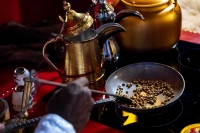
Saudi coffee preparation methods vary according to the customs and environment of each of the Kingdom of Saudi Arabia 's provinces. The difference is limited to the types of spices added to the beverage or the variation in the coffee roasting grades. The preparation of Saudi coffee in most of Saudi Arabia's provinces depends on common basic traditional ingredients. It is usually prepared by putting eight hundred ml of boiling water, then adding forty g of ground and medium-roasted cof...
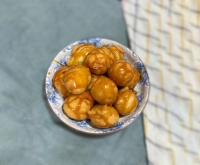
Luqaimat , also known as Luqmat Al-Qadi or Awama , is a popular traditional dessert in the Kingdom of Saudi Arabia, particularly in Makkah Al-Mukarramah and Al-Madinah Al-Munawwarah Provinces. It is one of the sweets commonly associated with the iftar table during the month of Ramadan for most Saudi families. Luqaimat history in Saudi Arabia Makkah Al-Mukarramah and Al-Madinah Al-Munawwarah Provinces are characterized by a diversity of food varieties due to their cultural diversity. Madinah A...
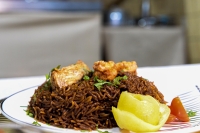
Traditional Dishes in the Eastern Province are the popular dishes known for being prepared by the residents of the Eastern Province in the Kingdom of Saudi Arabia . These dishes are predominantly seafood-based due to the Eastern Province's coastal location along the Arabian Gulf. Among them is ' Muhammar ,' also referred to as ' Burnyush ,' which is one of the widely recognized traditional dishes locally in Saudi Arabia. Additionally, the dish ' al-Hanaini ' i...
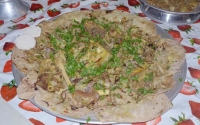
Traditional Food in the Northern Borders Province are traditional dishes that the Northern Borders Province is renowned for in the Kingdom of Saudi Arabia . Most of these dishes are associated with the winter season, as the Northern Borders Province is characterized by a predominance of cold weather. The ingredients of the province's traditional dishes are largely based on whole wheat flour, clarified butter, and yogurt. Whole wheat flour is considered a main ingredient in most of the trad...
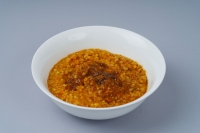
Harees soup is made from al-Habb al-Hassawi (seeds from al-Ahsa), which are cooked with pieces of meat for three hours under cover. Then, it is smashed until smooth. A portion of it is then taken and mixed with dried lime concentrate and boiling water. It is added in batches to a base of spices, which forms the foundation of many rich dishes and is referred to as ' al-Khishnah ' or ' al-Hamsa ,' consisting of spice broth cubes. A blend of spices that enhances the flavor is t...
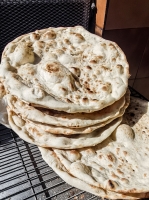
Tamees is a popular type of bread commonly served at breakfast and dinner tables in the Kingdom of Saudi Arabia. It is made using white or whole wheat flour and was initially known in the Makkah al-Mukarramah Province before spreading to other provinces of Saudi Arabia. The origin of Tamees in Saudi Arabia Makkah al-Mukarramah Province has been known as one of the most culturally diverse areas in Saudi Arabia in terms of culinary traditions, due to its religious centrality as the home of al-Kaa...
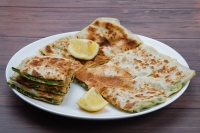
Mutabaq is one of the traditional dishes in Makkah al-Mukarramah Province in the Kingdom of Saudi Arabia. Its preparation practices are well-known in the cities of the western region of Saudi Arabia in general. As a traditional dish, Mutabaq can be easily found at national festivals in general and heritage festivals in particular, such as the Historic Jeddah Festival and the Klija Festival in Qassim. Mutabaq represents a continuation of the diverse culinary traditions in Saudi Arabia, particula...
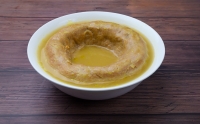
Traditional Food in Al-Bahah Province refers to the most renowned dishes in Al-Bahah Province , located southwest of the Kingdom of Saudi Arabia. Most of these dishes have wheat products as their main ingredient. Wheat is also an essential ingredient for several baked goods dubbed with various names differing per their preparation and baking. These goods include Mifa bread, Tannour bread, and Muqana bread. Al-Bahah province shares some traditional dishes with Aseer Province . These dishes inclu...
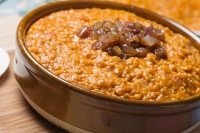
Traditional Food in Al-Jawf Province refers to the most renowned dishes in Al-Jawf Province , located north of the Kingdom of Saudi Arabia. These dishes are known for their common ingredients for locals. These dishes include al-Jawf Marqooq , al-Mathan bread, and Jareesh with ghee. Bakeelah is a popular dessert in al-Jawf Province. It consists of collected sweet dates to which opophytum and ghee are added and kneaded before being served to guests. Ingredients of traditional food in al-Jawf Prov...
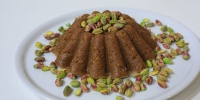
Dates are a common ingredient in many traditional dishes across different provinces of the Kingdom of Saudi Arabia. Qassim Province is renowned for being the largest producer of dates and for preparing a variety of dishes that incorporate dates, such as al-Hanaini , the date paste used in the preparation of Klija —for which Qassim Province is considered a local and Gulf supplier—and most notably, al-Qashd . Al-Qashd Dates and millet flour are the two key ingredients to prepare al-Qashd, oft...